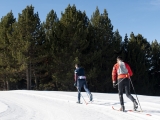Initially, we group athletes according to whether they suffer from a physical or sensory disability, so we will talk about the physical group and the sensory group.
It is the first group that most requires specific material for practice of skiing. It is divided, in turn, into two categories: standing category and sitting category.
Foot Category
This group includes people with disabilities in the upper extremities, the lower extremities or both, regardless of the reason for the disability: amputation, paralysis, polio, etc.

When the limitations are in the upper limbs, the most difficult thing is to adapt to the new equilibrium situation. It will be necessary to compensate for the lack of the limb or its mobility and look for the balance point or the necessary help to make turns, since there is no possibility of carrying a cane.
When the injury affects the lower limbs, we may be faced with tibial or femoral amputations. In the first case, conventional ski equipment is usually put on the prosthesis; that is, boots and ski bindings but with the addition of crutches that function as stabilizers, the end of which constitutes a small ski that is technically called stabilos (outrigers).
In the case of a mixture of injury, such as the femoral amputation of one leg and the tibial amputation of the other, the skier will use conventional material on only one leg. This is the same case as that in which there is only one amputated limb, with the additional difficulty, of course, of lacking the flexibility, rigidity and torsion of an uninjured leg and having a prosthesis instead.
There are also those people who, without actually missing a limb, suffer from a muscle deficiency that makes it difficult for them to open and close their skis or prevents them from preventing the boards from crossing. For these cases there are devices called sleders, which are placed on the tip of the skis and are joined together by hooks that allow the boards to be opened and closed without they cross paths.
This allows for easy wedge opening to facilitate turns. If you also have a sliding system that allows the tips to be lowered and raised, it is also possible to lift the ski. In any case, the skier always carries stabilizers in his hands.

Sitting category
This category includes people who suffer from serious mobility problems, caused by injuries such as paraplegia, tetraplegia, double femoral amputation and cerebral palsy. Depending on the degree of the injury, you can practice mono-ski or bi-ski skiing.
Monoski
It is the option that paraplegics or people with double femoral amputation tend to opt for. Also corresponding to this group are skiers who suffer injuries due to which they lack strength in their lower limbs, but who retain some trunk control and strength in their arms.
It is based on a custom-made anatomical seat, which rests on a structure equipped with a swing arm and a state-of-the-art suspension system that allows, as far as possible, , absorb and simulate the leg flexion-extension maneuver. The skier must also carry a pair of stabilizers which at the beginning of learning will be the support base on which they will obtain all balance. In a second phase, the stabilizers will become stabilizers in turns and will play an important function when making the driven turn.
As its name indicates, the monoski rests on a single conventional board, which may be equipped with conventional fixings or special hardware that is capable of supporting it.
Bi-ski
Bi-skiing is the system aimed at those severely affected people who lack trunk control and, in some cases, have little mobility in their arms.
The construction system is similar to that of the monoski, although it has a lower center of gravity, a much higher seat that provides greater support and is equipped with superior seat belts. But its biggest difference with the monoski is that it rests on two parabolic skis that They would be more or less in the shape of a snowboard split in two, with balancing systems that allow you to catch the edge when lying down.
Skiers in this modality will also carry stabilizers that, in many cases, will be attached to their hands with straps. In the most extreme cases, the bi-ski is equipped with lateral skis that serve as support for the balance and prevent, in a high percentage, cases of overturning.













